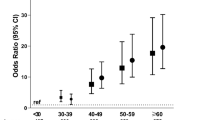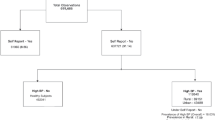Abstract
The aim of this study was to estimate the prevalence and incidence of hypertension in women, and describe their self-care and health-seeking behaviours. This research was conducted as part of the Australian Longitudinal Study on Women’s Health, a study comprising a nationally representative sample of Australian women in three age groups. The focus of this research is 14 099 women born in 1946–1951, who have been surveyed six times (1996–2010). Student t-tests were used to compare women who did or did not have hypertension by their health-care utilization. Longitudinal analyses were conducted using a Poisson generalized estimating equation model. The incidence of hypertension among this cohort during 1996 to 2010 ranged from 400 to 597 participants per survey, resulting in an increase in prevalence of hypertension from 20.9% in 1996 to 41.3% in 2010. For all survey periods, women with hypertension had a significantly higher average number of visits to doctors and allied health practitioners compared with women without hypertension (P<0.005). The use of complementary medicine (practitioners and self-prescribed treatments) by women with hypertension was significantly lower compared to women without hypertension (P<0.005). Over time, conventional health-care utilization was higher for women with hypertension compared with women without hypertension (adjusted RR=1.18; 95% CI: 1.14, 1.22; P<0.0001). Our findings show that women with hypertension are using a range of conventional and complementary and alternative medicine: with hypertensive women using more conventional medicine and less complementary and alternative medicine than non-hypertensive women. As such, health-care providers should communicate with their patients regarding their use of complementary and alternative medicine in their efforts to provide safe, effective and coordinate care.
This is a preview of subscription content, access via your institution
Access options
Subscribe to this journal
Receive 12 digital issues and online access to articles
$119.00 per year
only $9.92 per issue
Buy this article
- Purchase on Springer Link
- Instant access to full article PDF
Prices may be subject to local taxes which are calculated during checkout
Similar content being viewed by others
References
Olives C, Myerson R, Mokdad AH, Murray CJ, Lim SS . Prevalence, awareness, treatment, and control of hypertension in United States counties, 2001–2009. PLoS ONE 2013; 8 (4): e60308.
World Heart Federation. Hypertension. 2014. Available at http://www.world-heart-federation.org/cardiovascular-health/cardiovascular-disease-risk-factors/hypertension/ (accessed 8 April, 2015).
American Heart Association. Menopause and Heart Disease. 2013. Available at http://www.heart.org/HEARTORG/Conditions/More/MyHeartandStrokeNews/Menopause-and-Heart-Disease_UCM_448432_Article.jsp (accessed 8 April, 2015).
Go AS, Mozaffarian D, Roger VL, Benjamin EJ, Berry JD, Borden WB et al. Heart disease and stroke statistics—2013 update: a report from the American Heart Association. Circulatin 2013; 127 (1): e6.
Centers for Disease Control and Prevention. Blood Pressure: Make Control Your Goal Infographic. 2014. Avalable at http://www.cdc.gov/bloodpressure/infographic.htm (accessed 7 July 2014).
Pimenta E, Calhoun DA . Resistant hypertension incidence, prevalence, and prognosis. Circulation 2012; 125 (13): 1594–1596.
WHO. Self-Care in the Context of Primary Health Care. World Health Organization. Regional Office for South-East Asia: New Delhi, India, 1998.
National Center for Complementary and Alternative Medicine. Complementary, Alternative, or Integrative Health: What’s in a Name? 2014. Available at http://nccam.nih.gov/health/whatiscam?nav=gsa (accessed October 2008).
Adams J, Sibbritt D, Easthope G, Young A . The profile of women who consult alternative health practitioner in Australia. Med J Aust 2003; 179 (6): 297–300.
Adams J, Easthope G, Sibbritt D . Exploring the relationship between women’s health and the use of complementary and alternative medicine (CAM). Complement Ther Med 2003; 11 (3): 156–158.
Simon LS . Relieving pain in America: a blueprint for transforming prevention, care, education, and research. J Pain Palliat Care Pharmacother 2012; 26 (2): 197–198.
Nahas R . Complementary and alternative medicine approaches to blood pressure reduction: an evidence-based review. Can Fam Physician 2008; 54 (11): 1529–1533.
Li D, Zhou Y, Yang Y, Ma Y, Li X, Yu J et al. Acupuncture for essential hypertension: a meta-analysis of randomized sham-controlled clinical trials. Evid Based Complement Alternat Med 2014; 2014: 279478.
Posadzki P, Cramer H, Kuzdzal A, Lee MS, Ernst E . Yoga for hypertension: a systematic review of randomized clinical trials. Complement Ther Med 2014; 22 (3): 511–522.
Ernst E . Complementary/alternative medicine for hypertension: a mini-review. Wien Med Wochenschr 2005; 155 (17-18): 386–391.
Vora CK, Mansoor GA . Herbs and alternative therapies: relevance to hypertension and cardiovascular diseases. Curr Hypertens Rep 2005; 7 (4): 275–280.
Yen L, Jowsey T, McRae IS . Consultations with complementary and alternative medicine practitioners by older Australians: results from a national survey. BMC Complement Altern Med 2013; 13 (1): 73.
Robinson A, McGrail M . Disclosure of CAM use to medical practitioners: a review of qualitative and quantitative studies. Complement Ther Med 2004; 12 (2): 90–98.
Brown WJ, Bryson L, Byles JE, Dobson AJ, Lee C, Mishra G et al. Women's Health Australia: recruitment for a national longitudinal cohort study. Women Health 1998; 28: 23–40.
National Health and Medical Research Council. Australian Guidelines to Reduce Health Risks from Drinking Alcohol. 2015. Available at https://www.nhmrc.gov.au/health-topics/alcohol-guidelines (accessed February 2009).
Tu K, Chen Z, Lipscombe LL . Prevalence and incidence of hypertension from 1995 to 2005: a population-based study. Can Med Assoc J 2008; 178 (11): 1429–1435.
Janus ED, Bunker SJ, Kilkkinen A, Mc Namara K, Philpot B, Tideman P et al. Prevalence, detection and drug treatment of hypertension in a rural Australian population: the Greater Green Triangle Risk Factor Study 2004–2006. Intern Med J 2008; 38 (12): 879–886.
Australian Bureau of Statistics. Cardiovascular Disease in Australia: A Snapshot, 2004-05. 2006. Available at http://www.abs.gov.au/ausstats/abs@.nsf/mf/4821.0.55.001 (Accessed 10 April 2015).
Rumana JK, Christine PS, Parul C, Kerry JS, Lee W, Steven CL et al. A cross-sectional study of the prevalence and risk factors for hypertension in rural Nepali women. BMC Public Health 2013; 13: 55.
Howes F, Hansen E, Williams D, Nelson M . Barriers to diagnosing and managing hypertension: a qualitative study in Australian general practice. Aust Fam Physician 2010; 39 (7): 511.
Booth AO, Nowson CA . Patient recall of receiving lifestyle advice for overweight and hypertension from their general practitioner. BMC Fam Pract 2010; 11 (1): 8.
Armstrong AR, Thiébaut SP, Brown LJ, Nepal B . Australian adults use complementary and alternative medicine in the treatment of chronic illness: a national study. Aust N Z J Public Health 2011; 35 (4): 384–390.
Yeh GY, Davis RB, Phillips RS . Use of complementary therapies in patients with cardiovascular disease. Am J Cardiol 2006; 98 (5): 673–680.
Miller LG . Herbal medicinals: selected clinical considerations focusing on known or potential drug-herb interactions. Arch Intern Med 1998; 158 (20): 2200–2211.
Navin TJ, Stewart-Williams J, Parkinson L, Sibbritt D, Byles JE . The identification of diabetes, heart disease, hypertension and stroke in mid- and older-aged women: comparing self-report and administrative hospital data records. Geriatr Gerontol Int 2016; 16 (1): 95–102.
Roberts RO, Bergstralh EJ, Schmidt L, Jacobsen SJ . Comparison of self-reported and medical record health care utilization measures. J Clin Epidemiol 1996; 49 (9): 989–995.
Acknowledgements
The research on which this paper is based was conducted as part of the Australian Longitudinal Study on Women’s Health, The University of Newcastle and The University of Queensland. We are grateful to the Australian Government Department of Health and Ageing (DOHA) for funding and to the women who provided the survey data.
Author information
Authors and Affiliations
Corresponding author
Ethics declarations
Competing interests
The authors declare no conflict of interest.
Rights and permissions
About this article
Cite this article
Sibbritt, D., Davidson, P., Peng, W. et al. Hypertension: What are the self-care and health-care-seeking behaviours in women over time?. J Hum Hypertens 30, 783–787 (2016). https://doi.org/10.1038/jhh.2016.20
Received:
Revised:
Accepted:
Published:
Issue Date:
DOI: https://doi.org/10.1038/jhh.2016.20



